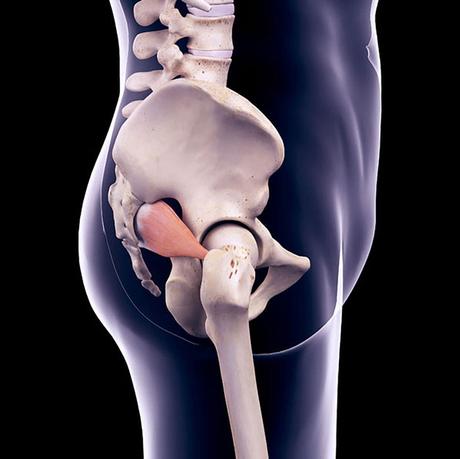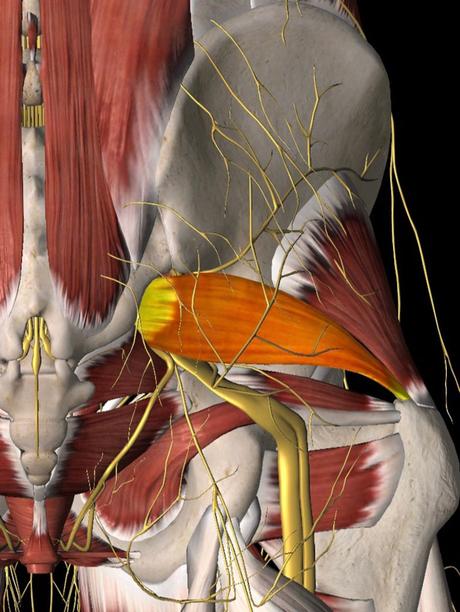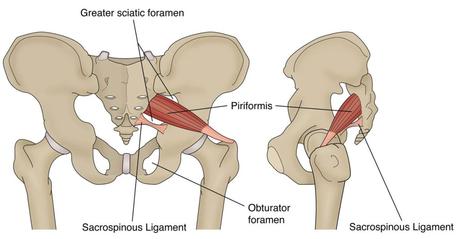Piriformis syndrome (PS) is a painful musculoskeletal disorder characterized by buttock or hip pain symptoms. Piriformis syndrome is when the piriformis muscle in the buttock region spasms and causes buttock pain. The piriformis muscle can also irritate the adjacent sciatic nerve, causing pain, numbness, and tingling in the back and inside the leg (similar to sciatica pain).
Piriformis syndrome occurs due to entrapment of the sciatic nerve at the level of the ischial tuberosity. While several factors may contribute to piriformis syndrome, the clinical presentation is relatively consistent. Patients often report pain in the gluteal region, characterized by shooting, burning, or pain in the back of the leg.

Cause of Piriformis Syndrome
The cause of piriformis syndrome is unknown, but its possible reason is:
- Muscle spasm in the piriformis muscle due to stimulation of the piriformis muscle or pelvic stimulation
- Muscle tightening in response to injury or spasm
- Swelling of the piriformis muscle due to injury or spasm
- Bleeding in the area of the piriformis muscle
Any of the above problems or a combination can affect the piriformis muscle or the adjacent sciatic nerve and cause pain, tingling, or numbness in the back of the thigh or leg.
Anatomy of The Piriformis Muscle
The piriformis muscle is a small, flat, and triangular muscle located deep in the pelvis and buttocks and starts from the bottom of the spine and attaches to the upper parts of the femur. The task of this muscle is to rotate the pelvis and the leg outwards. This muscle is placed diagonally, and the sciatic nerve is located vertically directly below it.
Diagnosis of Piriformis Syndrome
The diagnosis of piriformis syndrome is based on the patient’s medical history, physical examination, and diagnostic tests. This syndrome is often diagnosed by ruling out other complications, such as lumbar disc or sacroiliac joint dysfunction. The diagnosis methods are:
Physical Examination
A physical examination includes an examination of the hip and legs to determine whether movement increases back pain or lower extremity pain (sciatica). The pelvic motion usually re-creates the pain. This examination also identifies or rules out other possible causes of pain.
Medical History
The medical history includes an in-depth review of the patient’s symptoms, including what situations or activities make the symptoms better or worse, how long the symptoms have been present, whether they developed gradually or after a sudden injury, and what treatments have been given so far. In addition, the medical history includes checking for conditions that may run in the family, such as arthritis.
Diagnostic Tests
X-rays and other spine imaging studies cannot tell if the sciatic nerve is irritated in the piriformis muscle. However, diagnostic tests such as X-rays and MRIs may be done to rule out other conditions that cause symptoms similar to piriformis syndrome.
Also, the FIIR test can confirm the initial diagnosis and strengthen the evidence. In the FIR flexion, adduction, and internal rotation test, the hip joint is bent to stretch the piriformis muscle and compress the sciatic nerve. The delay in sending sciatic nerve signals due to the pressure caused by the piriformis muscle is measured in this test. An anesthetic injection may also help determine whether the piriformis muscle is the source of the symptoms.

Symptoms of Piriformis Syndrome
The most important symptoms of piriformis syndrome are:
- Chronic pain in the back of the pelvis and buttocks can spread to the lower thigh or back.
- Pain that may worsen with standing, sitting, or squatting.
- Pelvic pain may be during defecation.
- Pain that is felt in the morning when getting up.
- Increased hip pain with internal rotation of the thigh and its approach to the central axis of the body and bending of the thigh
- Pain when climbing stairs or slopes
- Decreased range of motion of the hip joint
Piriformis syndrome symptoms often worsen after prolonged sitting, walking, or running, and you may feel better after lying on your back.
Carpal Tunnel Syndrome What Causes A MigraineTreatment of Piriformis Syndrome
The treatment of piriformis syndrome starts with reducing intense sports activities. The movements that increase the pain should be stopped as soon as the disease symptoms begin.
The patient should not sit in one place for a long time and should get up every 20 minutes and walk a few steps. Alternating cold and heat therapy in the pain area and using non-steroidal anti-inflammatory and analgesic drugs such as ibuprofen and naproxen can also help reduce pain.
In alternating cold and heat therapy, perform one procedure for 20 minutes, rest for 20 minutes, and then continue the treatment with a new pad for another 20 minutes. Alternative therapies such as acupuncture and massage can also be helpful.
Physiotherapy helps restore the function of the piriformis muscle and prevents degeneration caused by improper use and malfunction of the surrounding muscles. In some cases, the method of electrical stimulation will be effective.
Sometimes piriformis syndrome is caused by trigger points commonly known as muscle knots. These nodes are usually found in the piriformis and gluteal muscles. A combination of pressure on these points and nodes, stretching, and strengthening exercises are recommended for treatment.
Rarely, suppose the patient does not recover after the above treatments. In that case, surgery may be performed by cutting the connection point of the piriformis muscle to the hip joint to eliminate the patient’s pain.
Also, injection of an anesthetic medicine in the area of pain in the buttock area may help. A local anesthetic and corticosteroid may be injected directly into the piriformis muscle to help reduce spasms and pain.
Botulinum toxin injection (Dysport or Botox) can be used for persistent piriformis spasms resistant to anesthetic injection treatment. Also known as Botox, this toxin, known as a muscle relaxant, may be helpful.
The purpose of Botox injections is to help relax the muscle and help reduce pressure on the sciatic nerve.

Piriformis Muscle Stretch
Stretching the piriformis muscle helps to reduce painful symptoms and increase the patient’s range of motion. There are many ways to extend the piriformis muscle, the two simple ways of which are:
- Lie flat on your back with both feet on the floor and bend both knees. Pull the right knee up to the chest, grab the knee with the left hand, pull it towards the left shoulder, and hold the stretch. Do this for both sides.
- Lie on your back, place both feet flat on the floor, and bend both knees. Place the right ankle on the left knee. Pull the left thigh towards the chest and hold the stretch. Repeat this for both sides.
Each piriformis stretch should be held for 5 seconds, to begin with, and gradually increased to 30 seconds and repeated three times daily. Consult your physiotherapist for the exact number of movements and the right amount for your condition.
Differential Diagnosis of Piriformis Syndrome with Lumbar Disc
It is essential to differentiate piriformis syndrome from the lumbar disc.
- The starting point of pain in piriformis syndrome is the sacroiliac region and hips, while in the lumbar disc, the pain starts in the lower back.
- In piriformis syndrome, coughing does not affect pain intensification, unlike disc herniation.
- The Lumbar disc is sometimes associated with urinary and excretion problems. At the same time, these problems do not exist in this syndrome. But sitting for a long time causes pain.
- Lumbar disc problem is shown using MRI, but piriformis syndrome cannot be diagnosed with MRI.

